The AMD A10-7700K and AMD A6-7400K CPU Mini-Review
by Ian Cutress on May 27, 2015 9:00 AM ESTOffice Performance
The dynamics of CPU Turbo modes, both Intel and AMD, can cause concern during environments with a variable threaded workload. There is also an added issue of the motherboard remaining consistent, depending on how the motherboard manufacturer wants to add in their own boosting technologies over the ones that Intel would prefer they used. In order to remain consistent, we implement an OS-level unique high performance mode on all the CPUs we test which should override any motherboard manufacturer performance mode.
All of our benchmark results can also be found in our benchmark engine, Bench.
Dolphin Benchmark: link
Many emulators are often bound by single thread CPU performance, and general reports tended to suggest that Haswell provided a significant boost to emulator performance. This benchmark runs a Wii program that raytraces a complex 3D scene inside the Dolphin Wii emulator. Performance on this benchmark is a good proxy of the speed of Dolphin CPU emulation, which is an intensive single core task using most aspects of a CPU. Results are given in minutes, where the Wii itself scores 17.53 minutes.
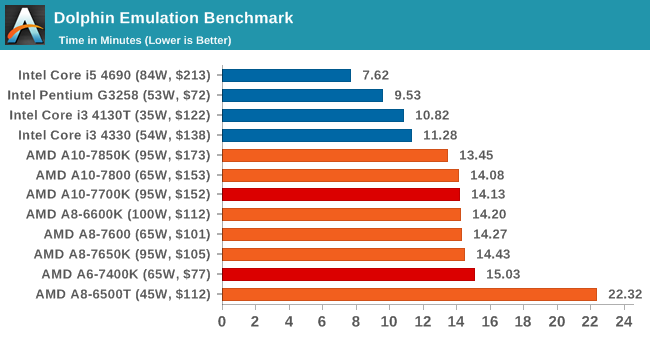
WinRAR 5.0.1: link
Our WinRAR test from 2013 is updated to the latest version of WinRAR at the start of 2014. We compress a set of 2867 files across 320 folders totaling 1.52 GB in size – 95% of these files are small typical website files, and the rest (90% of the size) are small 30 second 720p videos.
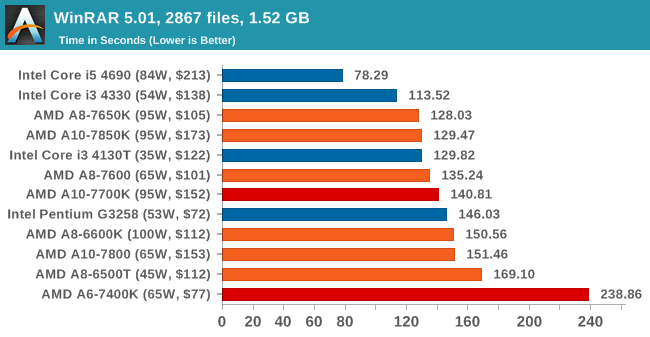
The single module of the 7400K shows the deficit in a slightly threaded workload.
Image Manipulation – FastStone Image Viewer 4.9: link
Similarly to WinRAR, the FastStone test us updated to the latest version. FastStone is the program I use to perform quick or bulk actions on images, such as resizing, adjusting for color and cropping. In our test we take a series of 170 images in various sizes and formats and convert them all into 640x480 .gif files, maintaining the aspect ratio. FastStone does not use multithreading for this test, and thus single threaded performance is often the winner.
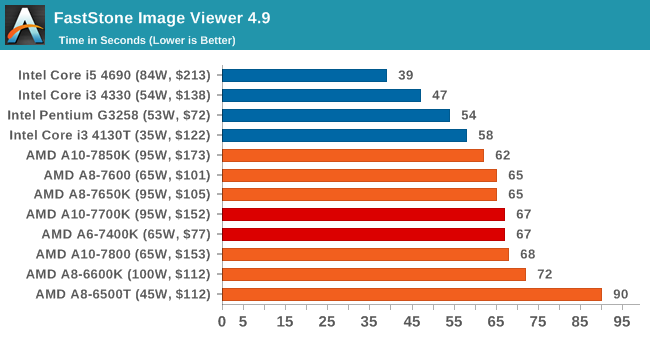
For a purely single threaded test, both of the AMD APUs performed similarly here.
Web Benchmarks
On the lower end processors, general usability is a big factor of experience, especially as we move into the HTML5 era of web browsing. For our web benchmarks, we take well known tests with Chrome 35 as a consistent browser.
Mozilla Kraken 1.1
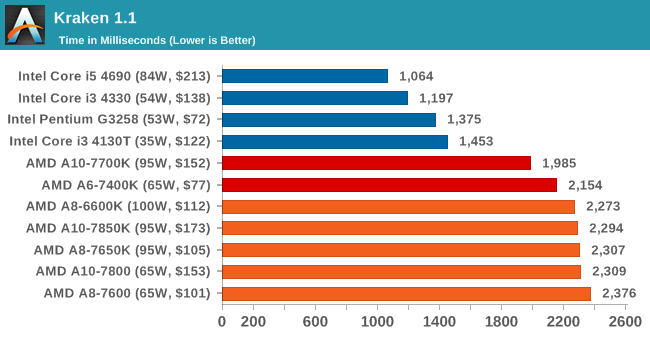
Google Octane v2

Professional Performance: Windows
We have a few benchmarks to characterise professional level performance on Windows.
Agisoft Photoscan – 2D to 3D Image Manipulation: link
Agisoft Photoscan creates 3D models from 2D images, a process which is very computationally expensive. The algorithm is split into four distinct phases, and different phases of the model reconstruction require either fast memory, fast IPC, more cores, or even OpenCL compute devices to hand. Agisoft supplied us with a special version of the software to script the process, where we take 50 images of a stately home and convert it into a medium quality model. This benchmark typically takes around 15-20 minutes on a high end PC on the CPU alone, with GPUs reducing the time.
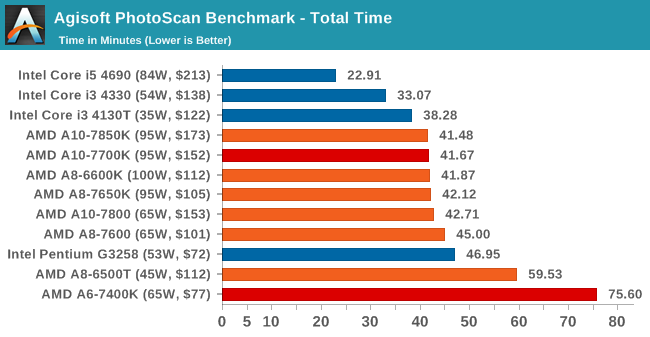
Cinebench R15
Cinebench is a benchmark based around Cinema 4D, and is fairly well known among enthusiasts for stressing the CPU for a provided workload. Results are given as a score, where higher is better.
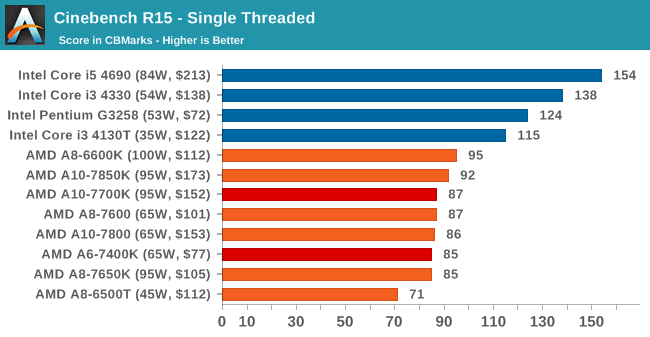

Linux Performance
Built around several freely available benchmarks for Linux, Linux-Bench is a project spearheaded by Patrick at ServeTheHome to streamline about a dozen of these tests in a single neat package run via a set of three commands using an Ubuntu 11.04 LiveCD. These tests include fluid dynamics used by NASA, ray-tracing, OpenSSL, molecular modeling, and a scalable data structure server for web deployments. We run Linux-Bench and have chosen to report a select few of the tests that rely on CPU and DRAM speed.
C-Ray: link
C-Ray is a simple ray-tracing program that focuses almost exclusively on processor performance rather than DRAM access. The test in Linux-Bench renders a heavy complex scene offering a large scalable scenario.
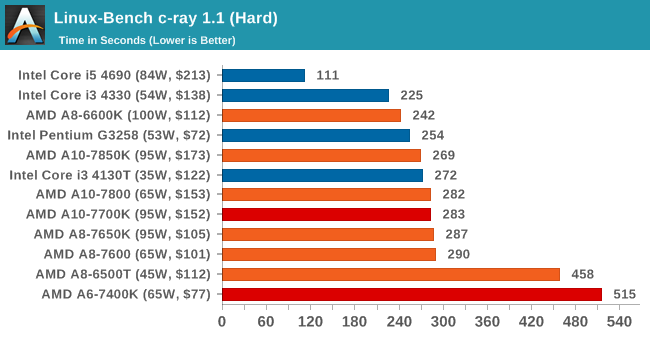
NAMD, Scalable Molecular Dynamics: link
Developed by the Theoretical and Computational Biophysics Group at the University of Illinois at Urbana-Champaign, NAMD is a set of parallel molecular dynamics codes for extreme parallelization up to and beyond 200,000 cores. The reference paper detailing NAMD has over 4000 citations, and our testing runs a small simulation where the calculation steps per unit time is the output vector.
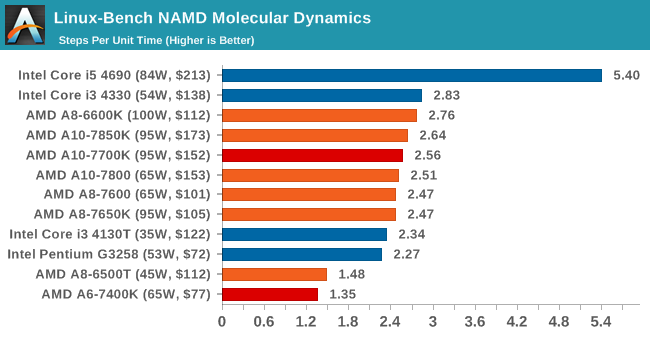
NPB, Fluid Dynamics: link
Aside from LINPACK, there are many other ways to benchmark supercomputers in terms of how effective they are for various types of mathematical processes. The NAS Parallel Benchmarks (NPB) are a set of small programs originally designed for NASA to test their supercomputers in terms of fluid dynamics simulations, useful for airflow reactions and design.











105 Comments
View All Comments
FlushedBubblyJock - Tuesday, June 2, 2015 - link
They're the space age ion cuntress shields, warriors, protecting the helpless and innocent from evil, cockblockers in their own minds, our heroes...zodiacfml - Friday, May 29, 2015 - link
Can't wait for HBM. Once they (AMD) have it on their APUs, Intel will have an equivalent shortly.ES_Revenge - Saturday, May 30, 2015 - link
Ugh, like the 7650K, these CPUs are both pointless nonsense.Like the 7650K v. the 7600, the 7700K uses more power, has a higher price (significantly this time--35%!) and offers very little (if any) performance increase over the 7600. (Just said this a week or two ago in the 7650K review, btw.) Plus the 7700K has no business even having the A10 name as it has the same 384SP as it's A8 siblings.
The A6-7400K should be more like $55, not $64. That's all I'm going to say there.
Fail and fail again :(
The stars here (if there are any in AMD's lineup) are the A8-7600 and the A10-7850K. The 7600 'cause it's 65W TDP and offers nearly identical performance to the 7650K which is 17% more and this new "A10" 7700K which is 35% more. Less power, same performance, less price? Hmm, what seems like the better CPU here? The foolishness-that-is the "A10" 7700K or the A8-7600? Not a tough decision.
I mean is this AMD's whole idea here? "Oh hey let's release two CPUs that are clearly worse value and that way we'll boost 7600 sales."??? LOL.
The 7850K offers the most performance and costs just a few bucks more than the 7800 so that's enough reasoning for me to make it the other stand-out.
The rest of these CPUs are all nonsense; and, because AMD is so far behind Intel in the CPU dept. not even the "stars" of AMD make much sense to most buyers. Sad. More sad is releasing CPUs that are simply pointless.
ES_Revenge - Saturday, May 30, 2015 - link
Oh and BTW don't get me started on the X4 860K. Save $4.00 ($4?! Really?) and *don't* get a GPU yet also have a higher possible TDP? WTF? Uh yeah it's "unlocked" but you're not getting much performance unless you're able to have a 1Ghz OC on the thing, but that's just going to cost you in more power/heat. X4 860K, for $84?....Worst. Idea. Ever.HomingTk - Monday, April 11, 2016 - link
thinking of getting a gaming pc (intended for gaming) with a AMD A10 7700k processor. From reaing the chat I don't know what to think about it. Considering there is possibly another option AMD R7 7650K what should I do?